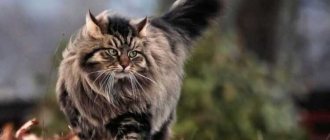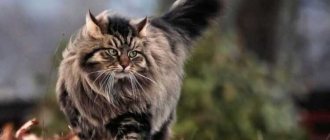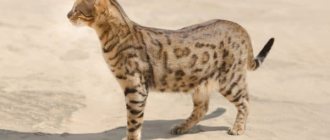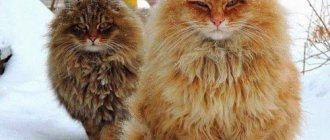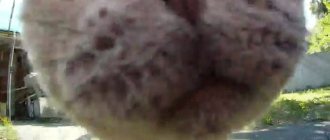Size of an adult Siberian cat
Due to the fact that this breed of cats had to fight for survival in harsh climatic conditions on the territory of the Siberian expanses of the Russian plain, it formed its size accordingly: as a result, the world now has the opportunity to see large and medium-sized beauties and beauties with semi-long hair , fluffy tail and cute facial expression.
Despite its ancient origin, the “Siberian” established its standards relatively recently: at the end of the 20th century . After this, it became possible to talk about the average or extreme weight of this marvelous animal. Of course, since the backbone of Siberian cats is powerful, allowing them to gain decent muscle mass, the weight, accordingly, can vary from 3 to 12, and sometimes up to 14 or more kilograms.
This is interesting! The average weight is considered to be the weight of an animal in the range of 6-9 kg. It should also be said here that representatives of the Siberian breed sometimes take as much as 5 years to reach their true appearance, but usually 3 years are enough for them.
Females can reach their size after their first pregnancy and birth. But despite their impressive size, which allows “Siberians” (both males and females) to engage in fights with strangers and even dogs while protecting their territory, you cannot deny them the grace and ease with which they happily walk along towering structures and objects, observing the situation in their domain from above.
In terms of size, the body of a Siberian beauty or handsome man should be from medium to medium-large, give the impression of massiveness, and body parts should be correctly proportioned. Size plays a less active role in the identification and assessment of Siberian cats than other factors, but the appearance of a representative of this breed should be healthy, and the pet itself should not have signs of malnutrition, such as: protruding ribs, collarbones, sunken sides; it must be active.
Lifespan
On average, Siberians live about 15 years. This is a significant age for cats, it corresponds to the age of an elderly person. However, life expectancy is directly affected by living conditions, proper nutrition and care. Stress and poor care reduce a pet’s life resource.
A cat needs human attention, and ordinary paper or even thread can become a toy for it. He has a developed instinct of self-preservation, which is why the animal never goes where it might be dangerous. The health of Siberians is excellent, in comparison with their counterparts of other breeds. Some individuals live up to 20 years. As for reproductive age, in cats it usually does not exceed 18 years, while in males it only occasionally crosses the eleven-year mark.
Siberian cat kitten size
Siberian cat cubs are born weighing approximately 60 to 130 grams. These indicators depend on the health of the cat, the number of kittens in the litter, the health of the kittens themselves and the presence of congenital defects. Typically, “Siberians” are famous for their health and therefore their chances for a successful outcome during childbirth and the further development of their offspring are great.
The kittens are blind and helpless - all worries fall on the mother . They eat about 12 times a day - mother's milk, and sleep the rest of the time. In the first month of life, their daily body weight gain is 12-15 grams. and by the end of this month the kitten's body weight may exceed half a kilogram.
Over the next month, kittens discover the world of adult food and become accustomed to clean water. Because of these nuances, as well as because of the kitten’s mobility, weight gain may slow down, but it may not slow down, and then the weight of a two-month-old fidget will reach a kilogram or more. In the third month of life, kittens actively spend their time, learn their mother’s wisdom with interest, and enjoy playing with their peers and owners.
This is interesting! By the end of this period, the weight of a “Siberian cub” kitten can reach one and a half or even two and a half kilograms. At the same time, males grow more intensively and already stand out externally.
Starting from the fourth month, when the kitten can safely move from its mother to a new family, its teeth begin to change, it requires solid food to train its chewing apparatus, and its weight can already reach 3 kg.
In the fifth month, the intensity of weight gain decreases, but the single portion increases; with this regimen, by the end of the month, the kitten can add half a kilo to its weight and reach 3.5 kg.
When the kittens reach six months of age, the frequency of their feedings decreases to 2 and therefore the intensity of their growth also drops, and then moves at a slow pace to the required mark. At six months of age it ranges from 3 to 5 kg.
Feeding
Siberians do not have any special breed characteristics regarding food. Therefore, it is important to consider the following basic recommendations:
- feed the animal high-quality food;
- Don't let us overeat;
- Do not offer foods that can harm the cat.
A cat's diet should be varied and balanced. The cat is a carnivore, and the best food for it is natural prey caught during the hunt - a mouse. The mouse consists of high-quality, perfectly balanced ingredients: protein, fats and carbohydrates. It contains many minerals, the liver is rich in vitamins, and the bones are rich in calcium. Unfortunately, few of us are able to provide our cat with such nutrition. But it is quite possible to compensate for it with other products.
The best food for a cat is a natural, hunted prey - a mouse.
All cats should not be given the following foods:
- bird bones and cattle rib bones (they can cause intestinal perforation);
- fatty foods;
- raw river fish;
- any sweets, culinary products, baked goods;
- any pickled, salted, canned foods, including herring;
- fried foods (meat, fish);
- potatoes in any form, peas, beans;
- sausages and smoked meats;
- stale food.
Nowadays there are many ready-made foods available on the market. Of course, it is easier to feed animals with them, but not always better. Preference is given to ready-made food, as a rule, because there is no opportunity or desire to tinker with natural products.
In terms of price, the difference is small, since high-quality industrial feeds based on meat, fish, offal and grains are expensive.
The cat should eat with appetite and not leave food in the bowl.
Siberians, as already mentioned, with insufficient activity can be prone to obesity. Therefore, you should adhere to the following rules:
- Feed the animal twice a day.
- Remember that only a healthy animal with normal food interest can eat exactly as much as it needs when given unlimited access to food. Therefore, it is better to limit this access.
- If the cat does not finish its portion, it means that it is already full. In this case, you should reduce the serving size.
- The cat should eat with appetite. If this does not happen with the usual food, there are two options - the cat is overeating or is sick. Watch her, if no one feeds her, then show the animal to the veterinarian.
- New food is introduced into the diet gradually, since cats are very conservative and may not immediately appreciate it. This is especially true for the transition from ready-made feeds to natural ones.
Weight table by age
| Age | Weight |
| newborn | 60-130 gr. |
| 1 Week | 250 gr. |
| 2 weeks | 370 gr. |
| 3 weeks | 500 gr. |
| 4 weeks (approximately 1 month) | 540-700 gr. |
| 8 weeks (approximately 2 months) | 1-1.4 kg |
| 12 weeks (approximately 3 months) | 1.5-2.5 kg. |
| 24 weeks (approximately 6 months) | 3-5 kg. |
| 48 weeks (approximately 1 year) | 4.5-7 kg. |
How does the size of a cat and a cat differ?
The size of an adult cat that has reached sexual maturity can vary from 30 to 33 cm at the withers, but can be higher. Cats are smaller in size than cats. However, the standards allow for variations in size differences between males and females.
This is interesting! It has been noted that cats of the Siberian breed reach a weight of 3-5 kg. or more, and cats from 4.5-6 kg. and more.
Thus, according to the TICA (The International Cat Association) standard, cats can be significantly smaller than males, the SFF (Feline Breeding Federation) standard also speaks about this, the ICEF (International Board of Expert Felinologists) also recognizes significant dimorphism between the sexes in Siberian cats, and FIF (Federation Internationale Feline) indicates that there is a difference in size between the female and the male (the female is usually smaller) and the same principle is followed by the CFA (The Cat Fanciers' Association, Inc.).
Description and appearance
The Siberian cat breed standards were adopted quite recently, some 20 years ago, or maybe more. The animal belongs to group II – Semi Longhair. According to the data, the animal should be medium or large in size, with female individuals always having smaller sizes. When participating in WCF exhibitions, a point scale is used to determine expert assessment.
Breed standards
Based on established FIFE standards, a Siberian cat must have:
- Slightly rounded and massive head.
- Wide and slightly rounded forehead.
- Well developed cheekbones.
- The nose is medium in length, wide, with a barely noticeable downward bend in profile, without the presence of a groan.
- A slightly set back chin that does not form a straight line compared to the top of the nose.
- The ears are medium in size, well opened at the base. The tips of the ears are rounded, with tufts of hair.
- The eyes are large and slightly oval, at the same time obliquely and widely set, having a uniform shade.
- The bones are strong, and the body is muscular and well developed.
- The chest is quite wide and the neck is powerful.
- The body is proportional.
- The limbs are of medium length, but quite strong.
- The feet are round and large, with noticeable hair between the toes.
- The tail is long and wide with a rounded end.
The coat should not be too long or poorly developed. A thick and dense undercoat should be visible, with the presence of water-repellent guard hair.
Interesting fact! In the summer, the Siberian cat can boast of fairly short hair, compared to the winter. In winter, both the woolen “collar” and the peculiar “pants” are clearly visible on the animal.
Any coat color that includes white can be considered standard, although shades such as Himalayan, chocolate, lilac, fawn and cinnamon are not included in the breed standards.
Behavior
The Siberian cat has a strong character, but at the same time it is a rather affectionate and loving animal that cannot offend either children or other animals. The breed easily adapts to any living conditions. In addition, the cat has innate hunting skills, so it is perfect for the private sector.
Interesting to know! The Siberian cat has a unique coat structure, so they are often used to treat osteochondrosis, neuralgia and rheumatic pain attacks.
Siberian cats easily learn their name and always respond to it. Despite the fact that this breed is considered large and may look like a massive and clumsy animal, it is incredibly agile and graceful. At the same time, he is easily provoked into active games, both with adults and children. She is incredibly inquisitive and will not calm down until she explores all the space around her.
✔ The Siberian cat is a Russian beauty with luxurious fur and a well-developed hunting instinct
Lifespan
Siberian cats live on average about 15 years, although this is not considered the limit. In this case, everything depends on a whole complex of reasons that can both shorten the animal’s lifespan and make it longer. Such important factors include living conditions, diet, sterilization or castration, regular veterinary examinations, as well as heredity factors.
What affects the growth of an animal
The main reasons influencing the growth and development of Siberian cats are, first of all, heredity, complete and balanced food, and proper care. Therefore, for those who want to have a “Siberian” as a friend, who inspires respect for its size, it would be a good idea to ask the breeder about the pedigree of the kitten being purchased, look at the previous litter of both one and the other parent (from a photo or through Internet resources), and see them matured children.
The probability of getting offspring that will reach large sizes and weight from parents who do not have such qualities and have not given such offspring before is too small. Of course, we are not talking about a Siberian cat reaching a super-giant weight or size as a result of overeating due to excessive overfeeding . Such “achievements” will not bring any good to the animal, but you will not end up with health problems: from the cardiovascular system to the short life expectancy of the “fluffy”.
But correct and balanced food, especially in the first years of life of Siberian cats, when their main vital body systems are formed, requires the inclusion of 70% protein in the food, which gives a start to the proper functioning of all organs in the future. And this rule should be observed until the pet reaches the final phase of its development, which, as is known, can take up to 5 years.
Important! Proper care, which includes taking care of the health of the Siberian cat, providing sufficient walking for the full development of muscle mass, is a direct factor influencing the development of representatives of this breed and their size and weight indicators.
After all, it is known that an individual infected with worms, other parasites, or in an unhealthy state loses weight, condition indicators, and in any case loses to a healthy animal in all exterior indicators. And most importantly, of course, she will not be able to bring the joy to the owner that she could give with her appearance alone, not to mention the lost time for life-affirming communication.
Buying a kitten
Choosing a kitten is a responsible step, because you are purchasing not just an animal, but a new family member who will become your faithful friend for the next two decades.
A Siberian pet will definitely become a member of your family, so you should take its choice seriously
Some tips:
- Prepare theoretically in advance: try to learn as much as possible about the characteristics of the Siberian breed and the rules for its maintenance.
- “Try on” the cat to your home conditions: think about where he will eat, sleep, go to the toilet, and play.
- Be sure to come to a consensus with all your family on the issue of purchasing a cat - the animal will feel comfortable if it does not bother anyone.
- In a timely manner, select everything necessary for the kitten: bowls for food and water, a tray, a scratching post, combs and toys, stock up on food.
And of course, the most important thing is to decide what kind of kitten, where and why you want to buy. As has already been said, there is nothing wrong with even bringing a cat into your home from the street, much less buying it at a bird market or borrowing it from friends. There are a lot of options - but none of them guarantee that a miracle will happen and thus a truly purebred animal will appear in your home. There is little chance that it will be at least healthy and with a stable nervous system.
A kitten from the street or from friends may differ from the breed standards, even if it looks very similar to a Siberian
How to choose
If you want guarantees, choose a reliable breeder first, and only then a kitten. The choice of nurseries that breed the Siberian breed today is quite large, and they all value their reputation. They will help you choose a child based on his expected prospects and your ambitions.
Do not buy a kitten that is too small - let him grow up a little next to his mother, who will teach the basic rules of cat behavior in the house
If possible, talk to the baby's parents - their appearance and behavior can outline the characteristics of the pet you choose. Listen to the breeder's recommendations - this will help you properly raise a healthy and beautiful animal.
Deviations from the norm
Individuals that have a body that is too short or, conversely, too long, are not recognized by felinologists as belonging to the Siberian cat breed; An animal that is too light and one that has poorly developed bones (too graceful) is also considered substandard.
Paws of medium length, sufficiently powerful in their condition, will be counted as a good breed trait, but too short, or, conversely, “stilted” or thin legs in a cat are a disqualifying trait, the same as a short tail.
Colors of this breed
Possible colors:
- Tricolor. The pet's muzzle, belly and chest are painted white. The fur on other parts of the body may be black, cream, or other shades.
- Red. The cat's coat is red or brick-colored.
- Bicolor. The leading color is white. Additional colors can be grey, red or black.
- Golden or silver. The golden hue is close to apricot. Silver - to match the color of the chinchilla's fur coat.
- Blue. The pet's fur has a blue tint. The nose, paw pads and paws themselves are gray.
- Nevsky Masquerade. This color is also called color point. The fur color of newborn kittens is white. At a more mature age, patches of dark fur appear on the pet’s paws, face and tail.
- Tortoiseshell. The predominant coat color is black. There are also red spots on the fur coat.
You might be interested in the Persian cat breed
Video about the size of the Siberian cat
A rare beauty , the Siberian cat will amaze everyone with the density and properties of its fur. The owners like their noble appearance to match their generous character. And what can we say about her hunting instincts - the highest score for courage, bravery and the ability to exterminate all rodents in the access zone, all this is worthy of praise. This breed has become truly friendly to humans, and it is unclear how the world could manage without such a gorgeous cat?
Original nicknames
An elite Siberian cat should not be called by a simple name; either a majestic and worthy old name is selected for it, or an original nickname that reflects its appearance and character traits:
- since the breed is Russian, then old Russian names are suitable - the cat Lyubava, Ulyana, Marfa, Varvara, Melanya, the cat Methodius, Nestor, Simon, Khariton, Miron, Elisha, Savely;
- aristocratic foreign names - cat Gloria, Isabella, Penelope, Jeanette, Charlotte, cat Archibald, Reinhard, Salvador, Oliver, Edgar;
- nicknames reflecting character - cat Vredina, Weasel, Bestia, Sissy, Quiet, Madonna, Princess, Sonya, Lighter, cat - Pirate, Master, Ataman, Grumpy, Mattress, Fat Man, Sparky, Demon; names reflecting color - cat Tuchka, Snezhana, Klyaksa, Cinnamon, Alba, cat Gray, Snow, Knight, Rufus, White, Black;
- according to the owner’s favorite delicacies - cat Toffee, Cookie, Bounty, Candy, cat Zephyr, Pate, Baguette, Lemon, Apricot, Donut, Biscuit, Raisin, Truffle;
- popular - Astra cat, Akira, Leia, Selena, Erica, Felix cat, Cody, Simba, Murphy, Kevin, Lucky;
- funny ones - the cat Button, Firecracker, Tablet, the cat Mityai, Boniface, Twix, Hippopotamus, Macho, Gypsy.
History of the Siberian cat breed
There are no special legends or secrets in the origin of the Siberian cat. The native Russian fluffy cat inspired Russian felinologists in 1980 to select a breed of cats, registered by clubs as Siberian. These were often semi-long-haired creatures, which became breeding material.
At first, the beauties remained popular only within Russia, but history puts everything in its place, and the beauty and amiable nature of the Siberian cat attracted the interest of foreign lovers of meowing creatures. Soon the wonderful cats began to be exported to other countries and the fluffies saw the Czech Republic, the USA, and Germany. There were also difficulties: not everyone was satisfied with the vague description of the cats.
By 1991, an international standard for a new breed had been approved, which remained popular only within Russia. Work to clarify the difference between Siberians and other purebred cats continued. The last approved standard was adopted in 1994, and it is still relevant today. Changes in the description affected the shape of the head and the description of the unique water-repellent three-layer coat of these cats.
Difference in character
Devotion. The Siberian cat chooses from all family members one to whom she will be faithful. And he may feel superior to others.
Calm. These cats will not actively frolic, jump on tables, or run from room to room.
What distinguishes them is elegance, as well as poise.
Caution. If there are strangers in the room, then your household member will behave carefully and you will not see her in the arms of strangers. But she will not show aggression towards strangers.
The lifespan of these cats is approximately 15–20 years.
Description of Siberian cats
The Siberian cat rightfully bears the title of Russian beauty. She looks lordly and presentable thanks to her well-developed large body with powerful paws. Small tufts of hair grow between the Siberian's toes.
The head is large and appears to be trapezoidal with rounded corners. According to the breed standard, the distance between the ears should correspond to the width of the ears. At the tips of the ears there are tassels, giving the muzzle a resemblance to a lynx.
The characteristics of the muzzle require harmony with the body of the body, so no points are allowed. The back of the head should be flat. By the shape of the head it is not difficult to distinguish a true Siberian from another similar breed. In addition, a smooth transition from the nose to the forehead is noticeable, and the Persian can no longer be passed off as this breed.
The description of the standard indicates large and round eyes with an expressive gaze.
A unique wool caftan is formed around a powerful, strong neck. Impressive shoulders exceed the width of the body. The body itself is superbly developed. Such power is considered a feature of the breed - any cat will be an excellent rat catcher and can compete in strength with some dogs.
The tail of cats is very fluffy and wide, but moderately long.
A sign of a purebred Siberian cat is thick, rather hard hair. These long-haired cats can be recognized by examining their coat: since it consists of two layers of undercoat and is stiff, it does not get wet. The hind limbs are dressed in thick, warm “pants.”
Those who decide to get a small or adult Siberian can be calm about the occurrence of allergies - the breed, despite its long hair, is defined as hypoallergenic.
The combined color of the cat is ideal for the wild conditions of Siberia. The color is noticeable from the first month of life and can be patterned or solid; a variety of colors are allowed, including black and white.
Sizes and weight of Siberian cats
Since these are cats with heavy, massive bones, then, despite their average size and dimensions, their not entirely light weight cannot be small. The height of an adult animal at the withers reaches 30 cm if it is a female, and 40 cm for a male.
The kitten gains weight from month to month, usually well, and nevertheless, the cat grows for a long time: the formation of all body parameters, weight and length is completed by the age of three or even five years.
When buying a cat from Siberia, you should ask how much it will weigh: males weigh heavily and amount to 6-8 kg, females are lighter. Their weight does not exceed 5 kg.
How to choose a kitten
If you want to get yourself a purebred Siberian kitten, contact reliable breeders. This is the only way you can be sure that you will get a healthy animal that meets breed standards. The cost of kittens varies individually, but usually starts at four thousand rubles.
It may be possible to purchase a purebred Siberian much cheaper. For example, often breeders want to keep a kitten with outstanding characteristics for breeding and give it away for a purely symbolic sum in co-ownership, but in this case you undertake the obligation to take part in the breeding work of the nursery. Breeders also send animals to other homes that are no longer used for breeding.
As a rule, breeders raise kittens up to four months and sell them already vaccinated, and some even sterilized. But these are already teenagers with all the physical charms of this age - angular and disproportionate. Therefore, it is better to look at photographs, or even videos, of your kitten at an earlier age. Conscientious breeders will be happy to provide you with such materials.
Siberian kittens grow and develop very slowly; they are fully formed only by the age of three to five years. Therefore, it is difficult to determine by the appearance of the baby what he will look like as an adult. Feel free to ask for all possible photographs of his other relatives. In principle, you can do this yourself, because most breeders have their own websites on which this information is presented.
A good Siberian kitten should have powerful paws, a wide chest, and strong bones. The eyes should not be too round, but slightly elongated. It is desirable, but not necessary, to have tassels on the ears; it is quite possible that they will appear later. It’s good if the kitten’s nose is wide and does not narrow from the bridge of the nose to the earlobe. A wide chin is also preferred, and its line should be level with the line of the nose. A harmonious and smooth transition from the forehead to the nose should not be abrupt, but still well defined.
A good Siberian kitten should have powerful paws, a wide chest, and strong bones.
The temperament of the kitten you purchase is important, and it must match yours. Also keep in mind that not only you choose your pet, but he also chooses you. Watch how he reacts to you, how quickly he gets used to it, hold him in your arms, play. And only then make the final choice.
Habits and character of Siamese cats
For breeding purposes, cats were once taken from harsh natural conditions, and this affects the character and habits of many generations of cats. This is an active and courageous hunter who will become a threat to all rodents in the house and in the area, and even the neighbor’s rabbits. The pet will enthusiastically bring both prey and some other thing in its teeth.
Judging by the reviews of satisfied owners, the Siberian cat is fearless and loves to defend its territory from uninvited guests in the form of strangers and strange animals. They also have no fear of dogs. The family pet will not be scared by sharp sounds. You can be calm, the cat will not get into trouble without a good reason - the nature of the animal requires you to first check whether everything is safe.
The intelligence of the breed allows you to begin not only raising, but also training your pet in early childhood. There will be no problems with obedience and toilet training.
Raising this furry animal is a real pleasure. They are not picky and willingly play games with any item offered. Families with children like these characteristics.
The description of the character of the four-legged roommate also includes the words “discreet, affectionate, attentive.” Friendship with an animal is possible only if there is mutual respect for each other’s personal space, so if your pet has climbed high up to the ceiling, let him sit there as long as his feline heart desires.
Siberian cat screams in the house
If your Siberian cat is wandering around the house and screaming, then first you should find out the reason for this strange behavior:
- One of the most common reasons is natural instincts. In such cases, it is urgent to sterilize the animal, give it a sedative with food, or introduce it to someone.
- If your pet is in pain, you should carefully examine it and take it to a veterinarian for examination.
- Some factor irritates or worries the Siberian. Observe the animal and fix the problem.
- The animal suffers from nocturnal hyperactivity. To get rid of this condition, prevent your pet from sleeping in the evening, try to occupy him with something, for example, playing with a teaser, a ball, or a laser pointer.
Feeding and caring for Siberian kittens
Surprisingly, such a thick coat of the breed does not require endless care. The grooming process includes brushing during the molting period, otherwise 1-2 times a month will be more than enough.
The animal's ears and eyes are cleaned once a week with damp, clean cloths or napkins. Nails need to be trimmed 1-2 mm as they grow, 2 times a month.
Proper maintenance of a Siberian cat requires that you sometimes let it go outside.
Feeding a Siberian kitten must be done in strict accordance with the nutritional plan developed by veterinarians. The genetic program of the breed requires a natural and varied diet, which the owner must take care of.
An important thing in the diet is that the food should contain a large amount of protein, especially during the growing period of kittens. Enhanced protein nutrition is important during the first three years; during this period, you need to feed the cat so that the protein in the diet is about 70%. After this, the protein level is reduced to 50%.
Care
The Siberian's magnificent coat requires some care. It is enough to comb it regularly (this is very important during spring and autumn molting) and, if necessary, bathe the animal.
These cats should be fed mainly natural meat (beef, poultry, rabbit or fish), which should make up about 70% of the total diet. Fermented milk products (cottage cheese, fermented milk) are periodically allowed, but fatty foods are not recommended.
Health of Siberians
Like a true Siberian, the cat pleases the owner with its excellent health. Only the owner can damage this natural quality through his careless actions and illiterate care. For example, it is enough not to complete all vaccinations according to the vaccination schedule on time, and a once healthy Siberian cat can contract a serious disease. Even if a cat does not have a walk, it does not mean that at home he lives in complete safety from all diseases.
When the time of puberty comes, and this is approximately 7-9 months, you need to decide whether to breed in the future, because it may be worth castrating or sterilizing an animal from which offspring are not planned. If mating does take place, then pregnancy occurs, lasting 63-69 days.
Siberian cats live 10-15 years.
Tips for choosing a kitten
When choosing a Siberian breed kitten, you need to remember about their various colors. Some sellers try to pass off animals of unknown origin as purebred kittens. Therefore, your pet must be purchased from trusted breeders or specialized nurseries.
It is better to buy Siberian kittens no younger than three months of age. By this age, the cat should already be accustomed to self-feeding and basic hygiene rules.
Watch your future pet. He should be moderately well-fed, with a mischievous character, and very active. The pet's eyes and ears should be clean, and the coat should be shiny and shiny. The color of a kitten may not be immediately recognizable, because the shades of some appear only at one year of age. Ask the seller to show the baby’s parents, study documents about their pedigree. By the age of three months, a kitten has its own veterinary passport, which contains information about routine vaccinations.
Buy a Siberian kitten
It is clear why the Siberian cat has become so popular in Russia and other countries of the world: its external characteristics attract the attention of numerous fans of cats with long hair.
There are enough nurseries where you can buy pedigree Siberians to avoid purchasing a cat with a provenance of dubious quality. If you pick up a kitten from your hands, there is a high probability that it will grow up not into a proud Siberian, but, at best, into a Norwegian forest cat, if you're lucky.
Siberian catteries offer to pre-book a kitten of a suitable class. On average, the cost of the Siberian breed is not particularly high by the standards of the cat market. Purchase cats aged 2.5-3 months, vaccinated and healthy, with the pedigree indicated in the metrics. Buying an inexpensive pet from someone who is supposedly of this breed is fraught with the lack of any documents at all.
The price for cats of the Siberian breed starts at a threshold of 5,000 rubles
and depends on the exterior of the animal and the characteristics of its pedigree.
What to name a Siberian kitten
Choosing a name for a new family friend can sometimes be difficult. When giving a kitten a nickname, people must understand that it should not only please them, but also suit the animal, its external characteristics, and habits. Most importantly, the Siberian cat should easily perceive its name, and, therefore, respond to it easily.
It’s better to come up with a nickname in advance, as the nursery will ask you what name to put on your passport. Many breeders, by old custom, expect the name to reflect the pedigree.
Names for boys and girls can be different, or they can be completely similar. It is worth sitting down and discussing with the whole family what is the best name for a Siberian cat , for this you should use a list of the best nicknames.
Name table
| Girl | Boy | ||
| Redhead Squirrel Cassie Frosya Dara Bonna Athena Mina Shiba Pusha Chunya Laska Eva Zira Rikki | Finn Vyusha Nyusha Rady Basya Vetka Fenya Lada Pear Chishka Dora Plyukha Fanta Kama Era | Chester Maurice Yust Ty Argon Archie Axel Cyber Cruz Bucks Miguel Smokey Pat Fluff Ivor | Erema Patrick Norman Light Evrik Samson Sam Charlie Shrek Cupcake Yukki Veles Karen Murik Nord |
Cost and where to buy
In Moscow, the price of a purebred Siberian kitten ranges from 15 to 25 thousand rubles (data as of February 2022). The final cost of a kitten depends on its exhibition prospects, pedigree and achievements of the parents.
You will, of course, buy a fluffy large kitten cheaper from your hands, but its origin, health and character may be far from Siberian. A real Siberian should only be taken from a Siberian breed nursery or from professional breeders.
Choosing a kitten
If you plan to participate in exhibitions with your pet, it is better to seek help in choosing from a specialist. No one can guarantee that a kitten will grow into a champion, and given the slow maturation of the breed, it is even more difficult to predict the baby’s prospects than other cats. This feature is worth considering if you plan to breed these animals in the future. The first heat in a Siberian cat usually occurs about a year, but it is recommended to carry out the first mating only on the third. Pregnancy lasts just over two months. Often, labor occurs between 64 and 72 days.
When choosing a Siberian cat kitten, you should not take the smallest or calmest kitten in the litter, this may be a sign of poor health. The baby must be clean, well-fed, energetic and meet people without fear. Approximately the color will be clear almost immediately, but will be fully formed later, and will be fully established by the age of two years. If you are going to adopt a white kitten, make sure that everything is fine with his hearing - congenital deafness is often found in white kittens, regardless of breed.
If your choice is a pet-class kitten that has been declared unsuitable for breeding, or you yourself are not ready to arrange your pet’s personal life, it is better to deliberately deprive him of reproductive function.
Surgeries for sterilization of cats and castration of cats are recommended to be carried out at the age of eight to ten months, when the body is already sufficiently formed, and sexual desire has not yet manifested itself in full force.
Nurseries
Kennels working with this breed are not difficult to find in almost every major city in Russia and neighboring countries. For example:
- “Tale of Siberia” (Moscow) - https://skazkasibiri.ru;
- “Great Joy” (Ekaterinburg) - https://www.sibirgreatjoy.com;
- “Noble Beast” (Chelyabinsk) - https://www.zzcats.com;
- “Sunshine” (Novorossiysk) - sibcats.info;
- GAF (Almaty, Kazakhstan) - https://www.gaf.kz;
- “Simbirtsit” (Minsk, Belarus) - https://simbircit.by.
Siberians are excellent companion cats for people with reserved personalities and busy schedules. These are not cats that you can cuddle around the clock. They will take as much attention from you as they deem necessary. They are affectionate, loyal, sociable, but require mutual respect from the owner. Perhaps reviews of the Siberian cat will help you decide whether such a pet is right for you.
Video on the topic
Siberian cat: what the owner needs to know
Conclusions about the breed
The Siberian cat received the right to wear a unique fur coat, which turned out to be easy to care for. The kitty takes excellent care of her coat herself. Another advantage of the breed is its high health indicator, provided that it is well cared for by the owner.
In a family, a cat quickly becomes a friend to every member of the household: it plays with children, gets along with other pets, and unobtrusively offers its company to everyone. In return, she expects only affection and attention!
Major diseases
The Siberian breed is distinguished by good and strong health; cats are almost not susceptible to various diseases. If there is improper care or congenital defects, then this will affect the external condition of your pet.
Congenital diseases are most often hypertrophic cardiomyopathy - a common disease among cats associated with heart problems, but this is the exception, not the rule.
Well, such diseases as lichen, fleas, worms, eye diseases. You can find out about treatment from your local veterinary pharmacies.
Important: This is one of the breeds that needs regular walks in order to maintain good shape and improve coat.
